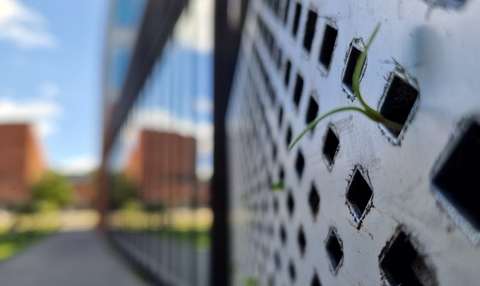Temporary structure, permanent impacts – Biodiversity Wall preserves nature in the city

Espoo is developing a Biodiversity Wall that can be used as a seed bank in green construction. Seeds, plants and organisms can be returned to nature from the wall, and the parts of the wall can be recycled for new uses. The pilot is part of the City of Espoo’s Sustainable Future Districts pilot programme.
At times, plants and flowers have to give way to construction sites. But help is underway: The Biodiversity Wall, InnoGreen and Kekkilä-BVB pilot project, which aims to utilise topsoil removed from construction sites and the seed bank it contains in urban green construction.
In the experiment, the topsoil and its seed and biobanks will be placed in a modular green structure, as close as possible to the original location of the soil. After the construction phase, the vegetation can be returned to its original place and the wall structures reused. The pilot will also examine how the new structure can add diverse urban green to the built environment.
The first pilot placed in Otaniemi
A Biodiversity Wall is now in place in Otaniemi, close to the stairway structure of Ekonominaukio 1. The wall is 3 metres wide and 1.8 metres high. Topsoil has been collected for the pilot at the Otakaari site in Espoo. The seeds are sprouting, and the plants are likely to be in full bloom in late summer.
The structure of the wall consists of three parts: a substrate utilising local topsoil, vegetation sown in the structure, as well as metal panels built from demolition waste. Some of the substrates are sown with meadow plants that support local species, which promotes diversity and creates a revitalising, green urban environment.
“The aim was to implement the substrate used in the wall using local recycled raw materials. In addition to topsoil, local manure compost was selected for the mixture,” says Hannes Rummukainen from Kekkilä-BVB.
“Green walls offer versatile benefits in a densifying urban structure. This pilot is particularly interesting because it adds a circular economy element to the equation by utilising demolition material, locally grown substrate and wild plants,” Mikko Sonninen from InnoGreen adds.
The wall benefits plants, people and the climate
The aim of the modular wall structure is to preserve the diversity of local biota and thus support biodiversity more extensively. The pilot collects information on how to preserve and utilise seed and biobanks in a densely built environment. In addition, the pilot also monitors biodiversity impacts, the cooling effect of the wall structure, as well as user experiences.
The Biodiversity Wall offers free ecosystem services, i.e. tangible and intangible benefits produced by nature for people. Indeed, the aim of the project is to promote human well-being and people’s connection with nature through green environment. The modular structure enables versatile use as construction site fences, noise barriers or green façades – either temporarily or as a permanent part of the environment. The Biodiversity Wall consists of fully reusable and recyclable parts, and its design is guided by the principles of the circular economy and climate friendliness.
Power of cooperation
One Biodiversity Wall will be built for the pilot, and its impacts and suitability will be monitored for the growing season.
The pilot is the result of close collaboration: Kekkilä-BVB is responsible for the substrate utilising local topsoil, while InnoGreen is responsible for the design of the structure in cooperation with Spolia Design. InnoGreen is also responsible for maintaining the vegetation. Aalto University Campus & Real Estate ACRE offers a place for the experiment on the campus, as well as support for the implementation of the project.
The project is also on display at the main event of the Espoo Nature Forum on 5 September 2025. Read more about the Nature Forum here.